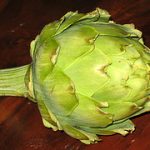
ARTICHOKE, GLOBE
When to Buy/In Season:
Artichokes are in season all year, with best supplies in March, April, and May
How to Select:
Look for: compact, plump heads, heavy for their size, with tightly closed, thick green leaves. Size is not an indication of quality. Avoid over-mature ones with hard-tipped, blemished, or spreading leaves. Once the bracts separate, the artichoke is well past it’s prime. Brown or black marks may be frost damage, which does not effect the quality of the choke, but often leads to a discounted price!
Organic Issues:
Most American artichokes are grown in the Monterey area of California. The climate is conducive for aphids, botrytis rot, and fungus, so most commercial artichokes are sprayed heavily with pesticides and fungicides. Organically grown artichokes are prone to “hiding” pests, so before storing in your home either
Shake upside down over the sink to dislodge earwigs or other pests
Soak in a large bowl of water mixed with 2 tablespoons salt and two tablespoons vinegar to remove earwigs and aphids
Pesticide Issues:
EWG 2009 Dirty Dozen, #x highest levels of pesticide residues
How to Store:
Fresh:
Refrigerate in a plastic bag with a few drops of water. Use within a few days
Frozen:
To Freeze Fresh Artichokes:
Prepare: Remove all leaves and choke or fuzzy portion. Cut away the stem just below the heart and trim any woody portions. Wash hearts in cold water and drain.
Blanch: for 7 minutes. Cool in iced water for 7 minutes. Drain.
Freeze: Pack in freezer bags or container, leaving no headspace. Seal and label.
Store: store freshly frozen artichoke hearts in the freezer (0F) for up to 6 months
Canned:
Store commercially canned artichoke hearts at room temp up to 8 -12 months
Photo Sources: Golf Bravo
Return to Buying and Storage Guides


